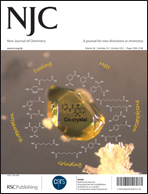The synthesis, characterization and formation of Langmuir–Blodgett (LB) films for the luminescent [(C12H25)2(CH3)2N][Eu(tta)4] complex, where [(C12H25)2(CH3)2]N+ is didodecyldimethylammonium and the tta ligand is thenoyltrifluoroacetone, are reported. The coordination of tta ligands to the Eu3+ ion was confirmed by FTIR spectroscopy and the emission spectrum comprised bands corresponding to 5D0 → 7F0–4 transitions. The lifetime (τ) from the emission state (5D0) was 0.41 ms, measured by monitoring the hypersensitive 5D0 → 7F2 transition, with the curve being fitted with a first-order exponential function. The surface pressure–area isotherm indicated that the anionic complex may form condensed structures at the air–water interface due to the amphiphilic properties of the counter ion and the β-diketone ligand. Y-type LB films of [(C12H25)2(CH3)2N][Eu(tta)4] were deposited on quartz substrates, with preserved luminescence and a band assigned to the 5D0 → 7F2 transition. The molecular arrangement at the air/water interface and the preserved luminescence in LB films are consistent with theoretical predictions using a semi-empirical Sparkle/AM1 calculation method for the molecule in vacuum. These tools were used for the first time to predict the behavior of organized films.

You have access to this article
 Please wait while we load your content...
Something went wrong. Try again?
Please wait while we load your content...
Something went wrong. Try again?


 Please wait while we load your content...
Please wait while we load your content...